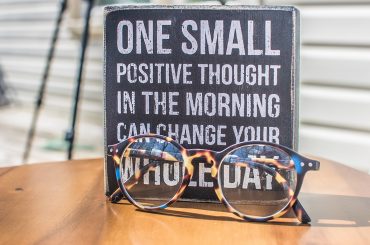Are there ways to be mindful when your life is full of chaos? Imagine your daily life becoming a little easier, a little brighter, and a lot less stressful. What if there was a way to boost your brain’s strength, dial down stress, shield yourself from anxiety and depression, enjoy better sleep, and elevate your mood – all without any unwanted side effects, except for a happier and calmer version of yourself?
What if you didn’t have to wait in line or exchange your hard-earned money for a handful of magic beans to access this transformative remedy?
Here’s the secret: it’s mindfulness, and it’s not just a passing trend. So, if you’re searching for practical ways to be more mindful and improve your well-being amidst the chaos of life, you’re in the right place.
What is Mindfulness?
Mindfulness is a state of mind where you’re completely tuned into what’s happening in the here and now. It means paying close attention to your thoughts, emotions, and the physical sensations in your body without any bias or criticism. It’s like being an impartial observer of your own inner experiences.
Instead of trying to change or fix anything, mindfulness encourages you to accept these inner experiences as they are, whether they are pleasant, unpleasant, or neutral. It’s not a goal-oriented activity, so there’s no need to achieve a specific outcome. Instead, it’s about being curious and exploring your inner world.
As you continue to practice mindfulness, you’ll start to notice how your thoughts, emotions, and bodily sensations are interconnected. Moreover, you’ll gain insights into how they impact your overall mood and influence how you react to the outer world. Over time, this understanding can empower you to make more conscious and balanced choices in handling various situations. Therefore, mindfulness helps you connect with yourself deeper and intentionally navigate life.
Why Should We Practice Mindfulness?
It’s not just some trendy fad; it’s a powerful practice that can make a real difference in your life. The main reason? It’s like your personal stressbuster. Being mindful helps you deal with life’s challenges by fine-tuning your brain’s stress-management abilities. In simple terms, it’s your secret weapon against stress.
But there’s more to it. Mindfulness is your emotional compass. It helps you navigate those emotional ups and downs and return to feeling balanced. So, think of it as a resilience booster—it can make you feel stronger when life throws curveballs. The best part? It doesn’t take much time. Nevertheless, even doing it for 25 minutes a day for three days, you’ll start noticing the effects.
If you suffer from anxiety, mindfulness acts as a mental shield by increasing brain activity in areas that deal with your thoughts and emotions. Hence, it’s pretty effective at reducing anxiety.
And it’s not just about your mental health; it’s about your physical well-being, too. This is great for your brain because it’ll slow down age-related cognitive problems, reduce physical pain without getting you hooked, and even improve your sleep.
When it comes to mental health, it can ease the symptoms of depression, protect adolescents from the weight of stress and anxiety, and help them become more self-aware. So, mindfulness is like a mirror that shows your thinking and behavior blind spots.
Modern life is filled with distractions, especially our tech addiction. It’s hard to focus when we’re constantly checking screens. Moreover, days pass without a moment for mindfulness, making us feel disconnected and unhappy. We often feel guilty for slowing down, thinking we must be busy all the time to be productive.
This leads to more vulnerability to negative news and anxiety. Additionally, we lose touch with ourselves and our inner strength. But there’s a solution. By practicing mindfulness, we can reconnect, find clarity, and regain control over our future.
Ways to be Mindful
It’s natural for your mind to wander, judge, or analyze things. But remember, mindfulness is all about being in the here and now. Yes, planning for the future and reflecting on the past is essential, but finding balance is vital.
If you’re new to mindfulness, don’t stress whether you’re doing it “right.” What matters is that you’re giving it a shot. With practice, it gets easier. Therefore, the more you do it, the better you’ll become at staying present and focusing on where you want it to be.
Here are some relatable ways to practice mindfulness:
-
Mindful Apps
In the digital age, our smartphones can be both a source of stress and a tool for mindfulness. Some great mindfulness apps offer guided sessions led by experienced practitioners. Furthermore, these sessions can gently introduce you to mindfulness through meditation and focus exercises. It’s like having a personal mindfulness guide right in your pocket.
-
Focus on Your Breath
You don’t need any fancy equipment or special skills for this one. Find a quiet spot, sit down, and take a few deep breaths. Also, pay attention to how your breath enters and leaves your body. When your mind wanders, gently guide it back to your breath. It’s like hitting a mental reset button.
-
Emotions
We all have emotions, and it’s okay to acknowledge them without trying to change them. So, take a moment to check in with yourself and recognize what you’re feeling. If you do this multiple times throughout the day, you’ll know how to respond instead of reacting.
-
Engage Your Senses
Your five senses are your connection to the here and now. When you’re eating, walking, or just taking a moment, let them come alive. Inhale the scents, savor the tastes, feel the textures, see the world, and listen to the sounds around you. It’s like opening a window to the present, inviting the world in.
-
Be Aware of Cravings
When you sense a need or craving, don’t push it away. Instead, feel how it sits within you. We often act on these urges automatically, without thinking. It’s like a reflex.
But here’s a different approach: Create a gap between the urge and your response. Let the craving be there and endure the discomfort. And trust that it will fade naturally, without needing instant gratification. It’s like letting a wave wash over you and knowing it will pass, leaving you in control of your choices.
-
Mindful Chores
There are chores that you can turn into a mindfulness activity. For example, mindful cleaning goes beyond just tidying up. It’s a practice of being fully present and paying attention to the details. As you clean, feel the smoothness of surfaces, notice the clarity that emerges, and savor the fresh scent of cleanliness. So, it’s about finding calm and fulfillment by creating a more ordered and harmonious space.
-
Take a Mindful Shower
Taking a shower can be like a mini escape from the everyday. The water’s warmth embraces you; the soap’s scent is familiar and comforting. It’s a moment to feel and experience truly. Notice the water’s temperature – is it just right for you? Watch it flow like a gentle, natural symphony. And keep an eye on any thoughts and feelings that come up during this time.
-
Take a Mindful Walk
Taking a mindful walk is like reacquainting yourself with an old friend. We walk a lot, often without thinking, and that’s perfectly normal. But sometimes, it’s refreshing to bring your awareness back to this everyday activity.
So, next time you take a walk, focus on how it feels. Sense the ground beneath you as you stroll, hear the world around you, and let your senses come alive. See the world with new eyes, listen to its sounds, and breathe in its scents as you move through it. It’s like rediscovering the joy in something you’ve done countless times before.
-
Savor the Flavor
We often eat while doing other things like talking, thinking, or multitasking. If you want to be mindful while eating, focus entirely on your meal without other distractions. Smell your food, savor its texture, and feel it nourishing you. Furthermore, be fully in the moment while you eat, without worrying about others or tasks awaiting you. Eating is a powerful act of self-care.
Pay attention to the thoughts and emotions that arise while you eat. Are you eating for nourishment or emotional comfort? What feelings bubble up? Joy, security, warmth, guilt, sadness? What self-talk accompanies your meal? Let go of judgment, as there are no right or wrong answers – just self-awareness. It’s like having a heart-to-heart with your food.
-
Be Present with Others
When you’re with someone, make it count. Notice them deeply – the sparkle in their eyes, the warmth of their voice, and how their words connect with you. If it’s a phone call, close your eyes to shut out distractions and truly be in the moment.
We often hear, but we’re not present. Our minds wander, planning responses or drifting elsewhere. Let’s change that and create genuine connections. Therefore, it’s like giving the gift of your full attention to the people you’re with.
-
Mindful Observation
In mindfulness, take a step back from your thoughts, observing them like clouds passing by. Create a sense of detachment, with no judgment or overthinking. Thoughts can sometimes morph into feelings, so give them space. So, let them drift in, and then let them drift away. If your mind starts to wander with a thought, return to your breath and connect with your senses. What can you see, feel, hear, taste, and smell? It’s like taking a mental step back to find calm in the present moment.
-
Follow Your Bliss
Find your passion and savor it fully. When you immerse yourself in what brings you joy, put aside the distractions and let your senses feast on the experience. So, it’s like stumbling upon a small piece of heaven in your everyday life – a moment that’s all about you, filled with happiness, and free from any disturbances.
These techniques aren’t about piling more on your already busy plate. They’re a way to uncover the treasures in your daily moments. As you practice, you’ll realize that mindfulness naturally weaves into your everyday life, making each moment richer. So, don’t hesitate – embrace the now and relish the gift of being fully present.
The Bottom Line
In our busy lives, it’s easy to get lost in the hustle. So, mindfulness is like a gentle pause button, making ordinary moments meaningful. It’s about engaging your senses and savoring the day without distractions.
Every day, there are chances for mindfulness – in routine tasks like showering, dishes, or just being. Furthermore, the key is being fully present, having senses on, and having no past or future worries. It might seem tricky, but it feeds your mind, body, and spirit.
For newbies, patience is vital. Your mind might resist, but that’s okay. So, start where you are and practice. You’ll get there. It’s a journey worth taking, beginning with the simple act of being in the moment.





